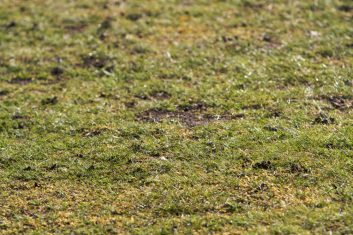Hello.
To discuss this subject fully, it will help us to first define it.
So what is a lawn?
The RHS has no easily obtainable definition of a lawn.
The Oxford online dictionary, however, describes a lawn as,
“An area of short, regularly mown grass in the garden of a house or park.” (Ref 1)
Wikipedia, I believe, has by far the best description:
“A lawn is an area of soil-covered land planted with grasses and other durable plants such as clover which are maintained at a short height with a lawnmower and used for aesthetic and recreational purposes. Common characteristics of a lawn are that it is composed only of grass species, it is subject to weed and pest control, it is subject to practices aimed at maintaining its green colour (e.g., watering), and it is regularly mowed to ensure an acceptable length,[1] although these characteristics are not binding as a definition. ” (Ref 2)
Well, let me break that down for you then. Firstly an area of “grasses”. Well the grass family, which is known as Poaceae, has over 10,000 species according to the Encyclopaedia Britannica (Ref 3). These cover plants from bamboo, ornamental grasses and those more suited to regular mowing in a lawn situation.
The most common species used in UK lawns (Ref 4 and Ref 5) are:
- Dwarf Ryegrass. Dwarf ryegrass is also known as Turf Ryegrass, (Lolium perenne)
- Red Fescue (Festuca rubra commutata)
- Slender Creeping Red Fescue (Festuca rubra rubra)
- Common Bent (Agrostis capillaris)
- Brown bent (Agrostis tenuis)
- Smooth-stalked Meadow Grass (Poa pratensis)
- Annual Meadow Grass (Poa annua)
So your lawn consists mainly of grass, it is likely to be a cocktail mix of between 2-4 of the above species.
As with cocktails, there is a formulae which you can buy, or mix your own and tweak it to suit your personal taste. For most lawns I would recommend you stick to a pre-mixed pack for simplicity and to save unnecessary costs.
3 most common grass seed mixes:
Luxury – Dense grass that tolerates frequent and short mowing and so can look amazing.
Utility – Less dense grass, that tolerates being crushed when walking or playing sport.
Shady – Less dense, tolerates poorer light conditions.
The grass species chosen for the mixes are marketed to you, the end user, based solely on usage. However, I feel, your soil type and garden situation are often more important factors.
For example, if you have sandy soil the grass needs to be able to cope with times of drought, as water will quickly drain out of the soil. Or on clay soil the grass must be able to deal with very wet and often also very dry conditions.
Soil types/properties can be exasperated or alleviated due to situational factors. For example, if the location of the grass itself is totally exposed, it will dry out quickly. If it is shaded by buildings, trees and shrubs it will stay moister for longer.
Your soil consists of a mixture of materials, but for simplicity’s sake it can be categorised as either sand, silt or clay.
You can identify your soil type by either:
Taking a sample and sending it off to a lab.
By research the geography and likely soil type in your area: http://www.ukso.org/pmm/soil_texture.html
You can also test it yourself by hand using the following instructions.
http://soilquality.org.au/factsheets/soil-texture
I hope you have found the information above informative and useful. My next blog will be on lawn care/improvement/repair.
If you have a query about it or wish me to expand on a specific area please email me at
Bibliography:
Ref 1 = https://en.oxforddictionaries.com/definition/lawn
Ref 2 = https://en.wikipedia.org/wiki/Lawn
Ref 3 = https://www.britannica.com/plant/grass
Ref 4 = https://thelawnman.co.uk/a-quick-guide-to-british-grass-species/
Ref 5 = A Handbook for Horticultural Students by Peter Dawson


